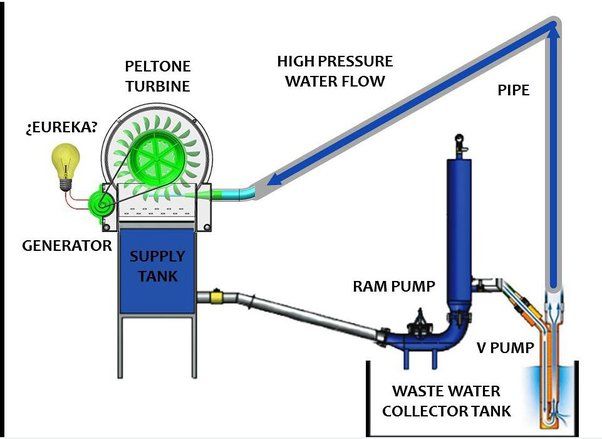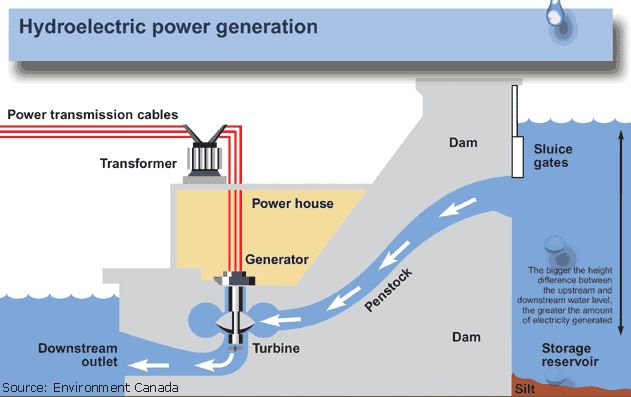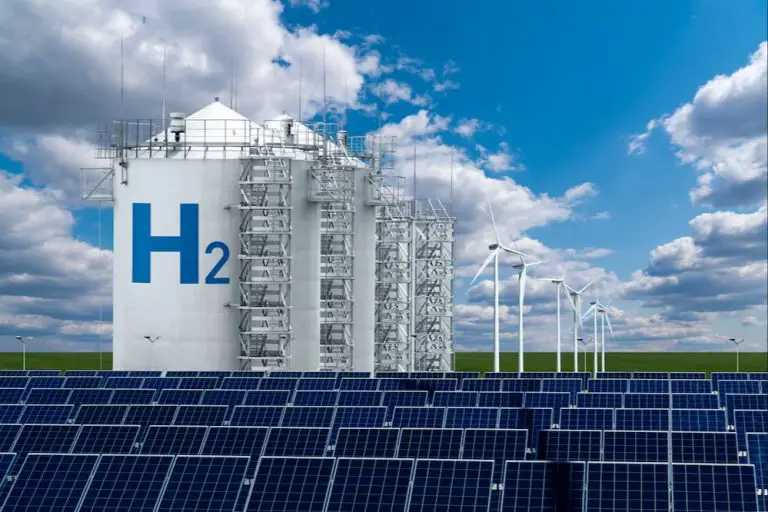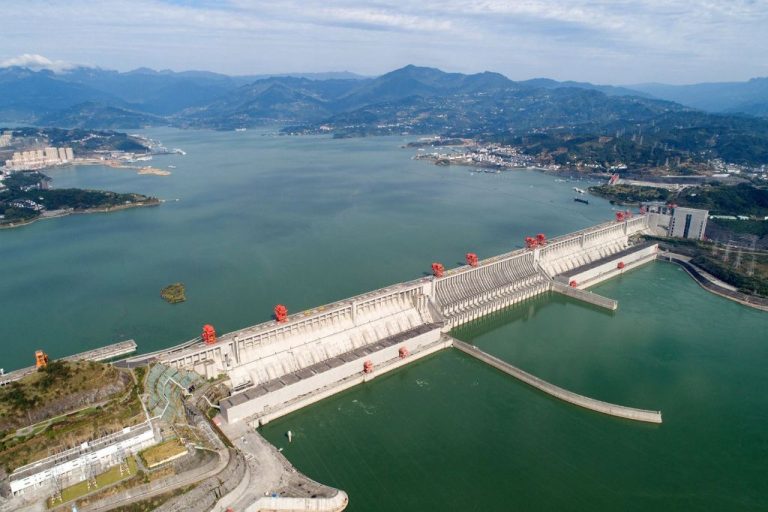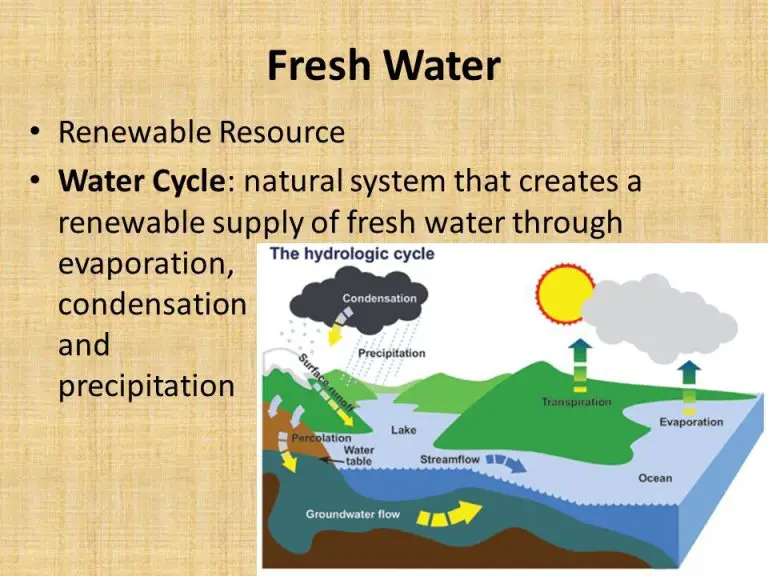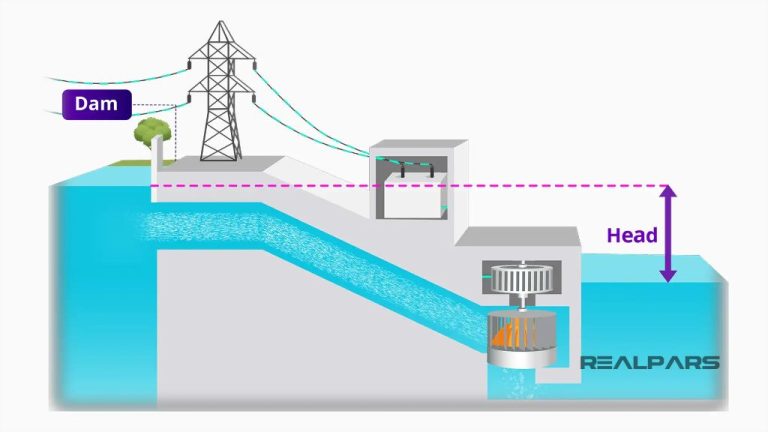How Do I Choose A Turbine For A Hydroelectric Power Plant?
Hydroelectric power is an important renewable energy source that relies on water to generate electricity. In hydroelectric power plants, the energy from flowing water is captured and converted into electricity using turbines. Hydroelectricity currently provides around 16% of the world’s electricity and is the largest source of renewable power. Choosing the right turbine is crucial for optimizing the performance and efficiency of a hydroelectric plant.
Hydropower turbines are rotary machines that convert the kinetic energy of flowing or falling water into mechanical energy to drive an electrical generator. There are several types of turbines used in hydropower plants, with the most common being Pelton, Francis and Kaplan turbines. The optimal turbine selection depends on factors like the head (vertical drop of water), flow rate and site conditions. This article provides an overview of the major turbine types and key selection criteria to consider for a hydroelectric project.
Types of Hydropower Turbines
There are two main types of hydro turbines: impulse and reaction. Impulse turbines, like Pelton wheels, utilize the velocity of water to move the runner and disperse energy. Reaction turbines, like Francis and Kaplan turbines, utilize pressure from water to move the runner and produce energy (https://www.energy.gov/eere/water/types-hydropower-turbines).
The most common turbines used in hydroelectric plants are:
- Pelton turbine – Impulse turbine that uses the velocity of water from a pressurized nozzle to turn the runner. Used for high head sites.
- Francis turbine – Reaction turbine that uses water pressure and flow to rotate the runner. Used for medium head sites.
- Kaplan turbine – Axial flow reaction turbine with adjustable blades. Used for low head sites.
Pelton turbines are suitable for high heads, Francis turbines for medium heads, and Kaplan turbines for low heads. The head, or height difference between intake and output water, determines the water pressure and flow rate, which affects turbine selection and design (https://www.enelgreenpower.com/learning-hub/renewable-energies/hydroelectric-energy/hydroelectric-turbines).
Turbine Selection Factors
The most important factors to consider when selecting a turbine for a hydroelectric plant are the net head and flow rate. The net head is the vertical distance the water falls from the intake to the turbines. The flow rate is the volume of water flowing per unit of time. Other key selection factors include:
Head Height – Impulse turbines like Pelton are used for high head sites, while reaction turbines like Kaplan are better for low head sites. Francis turbines can operate over a range of heads.1
Flow Rate – The flow rate through the turbines must match the available water flow to maximize efficiency. Turbine selection must account for seasonal variations in river flow.2
Site Conditions – Consider geological conditions, space constraints, and accessibility which can limit turbine options. Kaplan turbines are suited for river installations while Pelton can work for high mountainous regions.
Efficiency – Each turbine type has optimal efficiency zones in terms of head and flow. Selecting within these ranges maximizes energy generation.
Costs – Initial capital costs, maintenance costs, and the turbines’ operating lifetime should be evaluated when selecting a model.
Cavitation – For high heads, ensure the turbine can operate without cavitation erosion damage to the blades.
Generator Compatibility – The turbine must integrate properly with the generator in terms of rotation speed and power output.
Regulation Capability – Some turbines offer better output adjustments for fluctuating water flows and power demands.
Pelton Turbines
Pelton turbines, also known as Pelton wheels, are impulse turbines that utilize the kinetic energy of a high velocity water jet aimed at a runner with spoon-shaped buckets (Energy Education, n.d.). The jet hits the buckets on the runner, causing the turbine to spin. The water then exits the runner into the tailrace. Pelton turbines are used for sites with a high hydraulic head and relatively low flow (Wikipedia, 2022).
Pelton turbines operate with heads typically ranging from 50 to 1,800 meters. The numbers of jets and buckets impact the regulation and power output capabilities (Energy Education, n.d.). Advantages of Pelton turbines include their ability to operate at high heads efficiently, mechanical simplicity, and ease of regulation by nozzle or flow control. Disadvantages are their need for a relatively steady supply of water in the penstock to avoid power fluctuations.
Regulation methods include using spear valves or deflectors to regulate the water jet flow as well as using governors to control the spear valves. The velocity of the water jet needs to be maintained between 0.3 to 0.5 times the runner peripheral velocity for optimal efficiency (Energy Education, n.d.).
Pelton turbine materials are designed to withstand the high pressure jets while minimizing erosion. Typical materials include stainless steel, cast steel, cast iron, and nickel alloys for the runner. The housing and spear valve components are also high strength steel or stainless steel (Wikipedia, 2022).
Overall, Pelton turbines are a simple and effective impulse turbine technology for high head sites with relatively small flows. Their regulation capabilities and lack of complex submerged components make them an advantageous choice given the right site conditions.
Francis Turbines
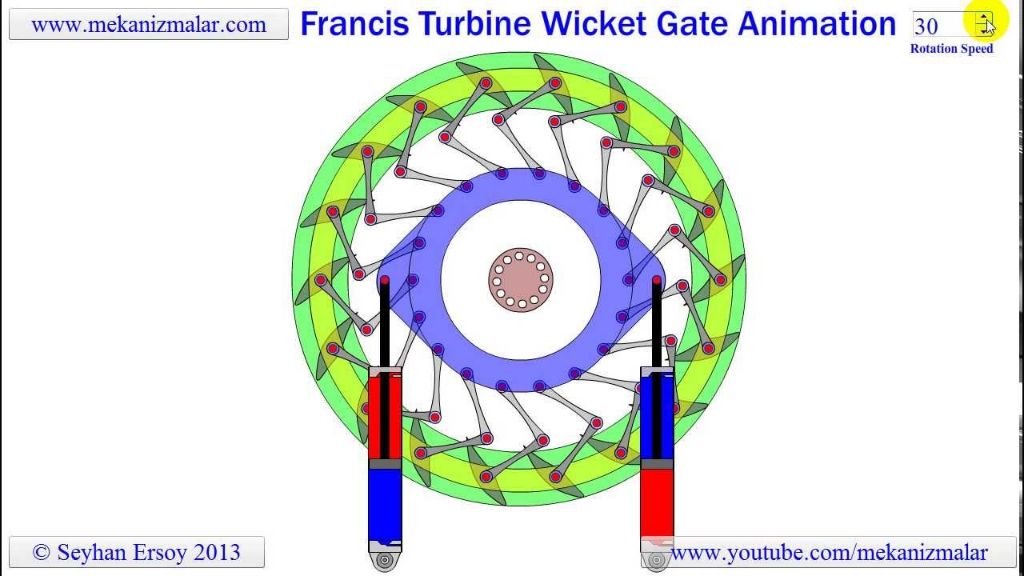
Francis turbines are the most common type of turbine used in hydropower plants. They operate with heads ranging from 10 – 600 meters and are named after British-American engineer James B. Francis, who invented the design in 1848 (Wikipedia, 2022). Francis turbines are reaction turbines, meaning they operate fully submerged in water. As water passes through the runner (rotating part), the runner blades convert the water’s energy into rotational kinetic energy. The runner is connected to a shaft that rotates and powers a generator to produce electricity.
Francis turbines are highly efficient, achieving over 90% efficiency in larger sizes. They have adjustable guide vanes that allow efficient operation over a wide range of flow conditions. This makes Francis turbines ideal for sites with seasonal water flow fluctuations. The ability to operate at partial loads also enables precise output regulation for meeting electricity demands (GE Renewable Energy, 2022).
Advantages of Francis turbines include their high efficiency, flexible operation, simple design and low maintenance costs. Their main disadvantage is cavitation that can occur at lower heads. Overall, the adaptability of Francis turbines makes them well-suited for a wide range of hydro sites.
References:
Wikipedia. (2022). Francis turbine. https://en.wikipedia.org/wiki/Francis_turbine
GE Renewable Energy. (2022). Francis Hydro Turbine. https://www.ge.com/renewableenergy/hydro-power/large-hydropower-solutions/hydro-turbines/francis-turbine
Kaplan Turbines
Kaplan turbines are axial-flow reaction turbines that consist of a runner with adjustable blades mounted on a hub [1]. They are named after their inventor, Austrian professor Viktor Kaplan, who developed them in 1913 [2].
Kaplan turbines are well-suited for sites with low head (5 to 40 m) and high flow. The blades can rotate around their axis to match the angle of the flow for optimal efficiency. This allows Kaplan turbines to operate efficiently over a wide range of flow conditions [1].
The main advantages of Kaplan turbines are [2]:
- High efficiency over a wide range of heads and flows
- Good part-load performance
- Adjustable blades allow customization to site conditions
The disadvantages are [1]:
- More complex design than fixed-blade turbines
- Higher cost due to adjustable blade mechanism
- Requires more maintenance than simpler turbines
Turbine Design and Materials
The design of the turbine is critical for optimizing efficiency and power output. Some key considerations include:
Number of runner blades: More blades increase efficiency but reduce speed. Pelton turbines often have buckets with splitters for more ‘blades.’ Francis and Kaplan turbines typically have 13-27 runner blades.
Materials: Runners are typically stainless steel or cast steel. Other components like wicket gates and shafts use materials like steel, cast iron, and chromium steel for strength and corrosion resistance.
Wicket gates: These adjustable vanes regulate and direct water flow onto the turbine. Their design impacts efficiency.
Bearings: Guide bearings support and align the shaft while limit axial movement. Thrust bearings handle hydraulic forces. Materials like babbitt metal are commonly used.
Shaft: The shaft transfers rotation from the turbine to the generator. High strength steel is typically used to withstand torque.
Casing: The casing houses and protects the turbine components. Steel or cast iron housings are common.
Proper materials selection and engineering design optimizes efficiency, balancing factors like strength, fatigue resistance, and corrosion issues. Regular inspection and maintenance helps maximize turbine lifespan.
Sources: https://www.alternative-energy-tutorials.com/hydro-energy/water-turbine-design.html, https://www.energy.gov/eere/water/types-hydropower-turbines
Turbine Regulation
Turbine flow and output is regulated through various mechanisms that control the flow of water entering the turbine runner. This regulation ensures the turbine operates within its designed limits and prevents damage from overspeeding or water hammer effects. The main methods for regulating turbines are:
Governing System
The governing system uses a governor and servo motor to adjust the wicket gates or turbine blades and control the flow based on the power output. If the output exceeds the set limits, the gates/blades close slightly to reduce flow. This system reacts quickly to load changes and helps maintain a steady frequency on the grid. Most governors sense turbine speed to control the gates/blades (Source 1).
Guide Vanes
Adjustable guide vanes redirect the water before it enters the turbine runner. Opening or closing the guide vanes controls the flow rate and velocity entering the runner. Guide vanes provide relatively fast regulation of flow for Kaplan and Francis turbines.
Relief Valves
Relief valves protect against overpressure by allowing water to spill out when upstream pressure gets too high. They are set to open at a predetermined pressure threshold. Relief valves prevent damage to turbines and other equipment from pressure spikes.
Proper regulation of the turbines is critical to ensure safe, efficient, and reliable operation of the hydroelectric system across different flow conditions. The governing system provides the primary speed/load regulation, while guide vanes help shape the water jet and relief valves protect from pressure transients. Careful design and adjustment of the regulation mechanisms is needed to optimize performance.
Installation and Maintenance
Proper installation and ongoing maintenance are critical for ensuring efficient, reliable, and safe operation of hydro turbines. Installation involves carefully assembling the turbine components, aligning everything precisely, and securing all parts as specified by the manufacturer. The turbine must then go through commissioning and testing before being put into service. This involves running the unit at various loads, verifying performance metrics, and making any needed adjustments. Thorough commissioning helps identify any defects or issues to address before the turbine is fully operational.
Once in service, scheduled maintenance and inspections become vital. Preventive maintenance tasks like lubricating bearings, replacing worn parts, cleaning debris, and checking bolts for looseness should occur at regular intervals per the manufacturer’s recommendations. For example, Ceoma Machining notes that major overhauls typically occur every 5-10 years. This involves disassembling much of the turbine for close inspection and replacement of aged components. Failure to properly maintain turbines can lead to reduced efficiency, capacity losses, and potential equipment failure.
Modern condition monitoring systems like vibration analysis, oil analysis, and visual inspections can also help predict problems and schedule maintenance. As noted by Mechanical Engineering World, technologies like these allow maintenance on an as-needed basis versus strictly time-based upkeep. This predictive approach minimizes downtime and costs compared to overly frequent or infrequent maintenance. Proper installation, testing, scheduled upkeep, and condition monitoring work together to maximize turbine lifespan and availability.
Conclusion
There are several important factors to consider when selecting the best turbine for your hydroelectric power generation project. The optimal turbine type depends on the head and flow rate available at your site. Pelton turbines are ideal for high head sites, while Kaplan turbines work best with lower heads and higher flow rates. Francis turbines offer flexibility for a range of head and flow conditions.
The specific turbine model should be sized properly to match your site’s head and flow. Consider the peak efficiency operating range when choosing the runner diameters and flow rates. Materials selection is also key – stainless steel, cast iron and welded steel each have benefits depending on your water chemistry and project budget.
Look for a turbine design that provides easy access for maintenance and allows adjustable wicket gates or runner blades to regulate power output. Partner with an experienced hydro turbine manufacturer who can provide modeling and analysis to optimize your turbine selection.
With careful evaluation of these key factors, you can choose the ideal turbine to maximize power generation and return on investment for your hydroelectric plant.

